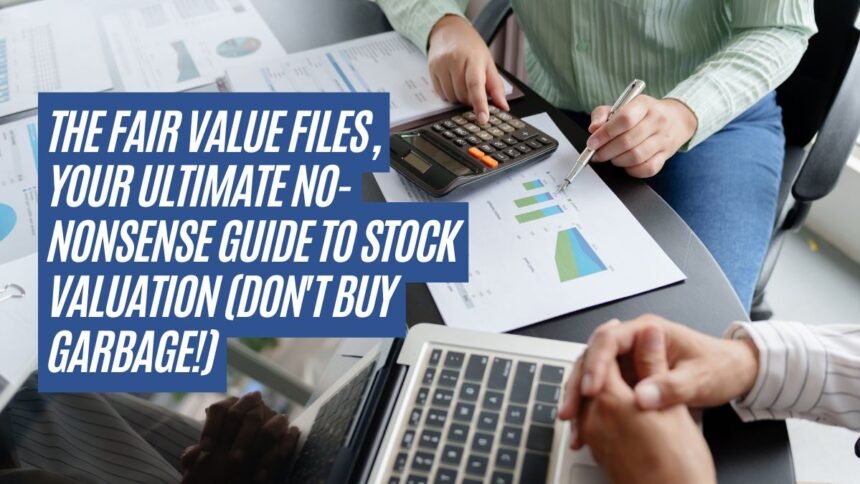Hey, my fellow future millionaires! Let’s be real. You’re on social media, you see those wild stock charts going vertical, and your brain just screams, “Buy! Buy! Buy!” Maybe you’re already in the game, feeling the stomach-churning ups and downs. But here’s the cold, hard truth, most people are speculating, not investing. They’re buying stocks because of hype, or because the price just went up. Yuck!
We’re better than that. We don’t want to overpay for a business, right? We wanna buy a gorgeous, money-making machine when it’s on sale. That’s why figuring out a stock’s Fair Value its true intrinsic worth is the absolute superpower of successful investing. Forget the daily noise. We’re talking value, baby, and it’s easier than you think.
Let’s dive into the four golden rules I personally try to live by the principles that have stood the test of time, straight from the Oracle himself, Warren Buffett. This is the stuff that actually matters.
1. The Underrated MVP, Invest in Yourself
Honestly, before you even type a ticker symbol into your brokerage app, stop. Look in the mirror. You’re the best asset you’ll ever own, period. Think about it, a stock can crash, the economy can tank, but the knowledge and skill you build? Inflation can’t touch that. Taxes can’t swipe it away. You just get better at what you do.
I’m not just talking about getting a degree. I mean reading a balance sheet, understanding discounted cash flow (DCF), or even just getting better at your actual job so your paycheck gets fatter. The money you earn on a stock is a nice bonus, but the value you add to your own life and income stream is the real compounding secret. Wouldn’t you agree? This is the foundation, without it, you’re just gambling with better tools.
Dedicate one hour this week to reading a reputable book or financial statement analysis course. Seriously.
2. Think Like an Owner, Not a Stock Trader
You’re not buying pieces of paper, you’re buying a piece of a business. This is the mindset shift that separates the winners from the crowd. Most people treat stocks like trading cards buy low, sell high, check the chart every five minutes. Ugh. That’s exhausting, and it rarely works long-term.
When I look at a company, I’m asking myself, “If I bought this whole thing and ran it for the next 20 years, would I be happy?” I look for what Buffett calls an ‘Economic Moat.’ Is the business protected? Does it have a brand that can’t be copied (like Coca-Cola)? Does it have a cost advantage, or a ridiculously high switching cost for customers (like certain software)? If the moat is weak, the business is probably garbage, no matter how “cheap” the stock looks today. We want fortress companies, not leaky buckets. Ignore the daily price ticker, focus on the business’s enduring power!
When researching your next stock, write down three things that make it impossible for a competitor to copy or replace it.
3. The Unshakeable Shield, Margin of Safety (MoS)
Okay, now for the math bit, but I promise it’s fun! Margin of Safety is simply buying something for less than its true value. It’s your personal financial airbag. Think of it like this, you calculate that a gorgeous house is truly worth \$500,000. If you manage to buy it for \$350,000, you have a massive margin of safety a \$150,000 buffer against any problems (like a leaky roof or a neighborhood downturn).
In stocks, our calculation of “Fair Value” (usually through a DCF model or similar method the results are always estimates!) is like that \$500,000 house price. The Margin of Safety is the discount we demand. If I think a stock’s intrinsic value is \$100, I won’t buy it unless the market price is, say, \$70 or less. That 30% discount protects me if my valuation was slightly wrong (which it probably will be, because we’re not superhuman!) or if the company hits a temporary snag. Never pay full price! It’s the simplest way to reduce risk.
Whatever intrinsic value you calculate for a stock, demand at least a 20% to 30% discount before hitting the ‘Buy’ button. Seriously, be greedy.
4. The Counterintuitive Play, Be Fearful When Others Are Greedy
This is maybe the hardest rule to follow because it messes with our human emotions. When everyone is talking about stocks at the dinner table, when the news is all rainbows and sunshine, and prices are soaring guess what? That’s when you should be getting fearful. People are greedy, they’re taking stupid risks, and prices are probably inflated past their fair value.
Conversely, when the market is crashing, when people are panicking and selling their best companies at fire-sale prices (like during a pandemic or a recession)? That’s your time to get greedy. This is when you deploy the cash you’ve been patiently hoarding! We don’t try to time the market, we prepare for the inevitable opportunity the market will eventually give us. Keeping a significant amount of cash on the sidelines isn’t being lazy, it’s being a patient hunter ready to feast when the market throws a tantrum. Don’t waste your buying power on overpriced trash!
Check your savings account. Do you have enough cash ready to buy your favorite stock if it suddenly drops by 30%? If not, start saving today.
My Final Two Cents (And a Secret Confession)
Listen, this journey isn’t about getting rich quick. That’s a fantasy. It’s about getting rich slowly, but surely. I’ve certainly made mistakes I’ve bought stocks that looked cheap but were actually value traps, and I’ve been impatient and sold a winner way too early. We all do! The key is to learn from it and stick to these foundational principles. Stop looking for the magical formula or the next hot tip. Invest in yourself, buy great businesses with strong moats, demand a Margin of Safety, and stay patient with your cash until the right moment, you’ve got this. Now go do your homework! Happy investing!












